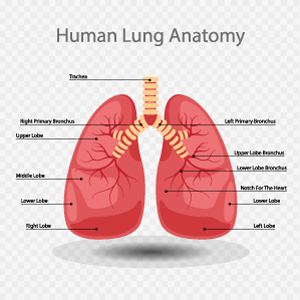Lung Anatomy

The lungs are divided into different parts which are called lobes. The right lung has three lobes called upper, middle, and lower lobes. The left lung only has two lobes, the upper and lower.
Where are the lungs found?
The lungs are found in the chest on the right and left side. At the front they extend from just above the collarbone (clavicle) at the top of the chest to about the sixth rib down. At the back of the chest the lungs finish around the tenth rib. The protective linings which cover the lungs (pleura) continue down to the twelfth rib. From front to back the lungs fill the rib cage but are separated by the heart, which lies in between them.
The air that we breathe in enters the nose or mouth, flows through the throat (pharynx) and voice box (larynx) and enters the windpipe (trachea). The trachea divides into two hollow tubes called bronchi. The right main bronchus (bronchus is the word for one of the bronchi) supplies the right lung; the left main bronchus supplies the left lung. These bronchi then go on to divide into smaller bronchi. The small bronchi divide into smaller and smaller hollow tubes which are called bronchioles – the smallest air tubes in the lungs. The medical term for all the air tubes from the nose and mouth down to the bronchioles is ‘the respiratory tract’. The lower respiratory tract is from the larynx.
At the end of the smallest bronchioles are tiny air sacs called alveoli. Alveoli are lined by a very thin layer of cells. They also have an excellent blood supply. The tiny alveoli are the place where oxygen enters the blood and where carbon dioxide (CO2) leaves the blood.




